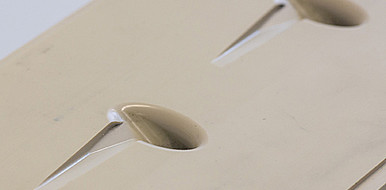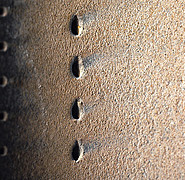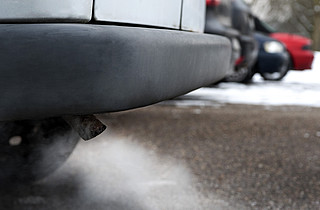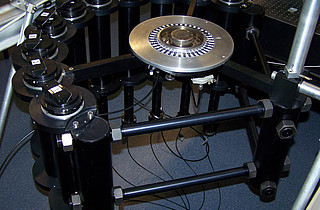Aerodynamic film cooling holes
The extremely high temperatures in combustors and turbines have a negative effect on the material properties of the highly stressed metallic components. By means of cool air between the metal surface and hot combustion air, the temperature of the components can be regulated. To keep the losses in thermal efficiency caused by this air cooling as low as possible, the cool air must be distributed as evenly and efficiently as possible over the component surface.
State of the art
A common method for this is film cooling holes: Here, the cool air is guided to the surface through internal channels and millimeter-small bores and distributes itself as a protective coolant film when it exits. With the usual sharp-edged, cylindrical holes from the direction of the cooling air channel, the air flows into the hole orthogonally to its orientation, resulting in high aerodynamic losses during deflection. In combination with a diffuser as outlet geometry, which fans out the cooling air, suboptimal flows as well as swirl occur in the bore. This ultimately leads to an uneven coolant film and a decrease in the cooling effect.
Technology
Scientists at the Institute for Thermal Turbomachinery (ITS) are improving the overall aerodynamics in the bore by modifying the inlet geometry on the cooling air side. For this purpose, a so-called NACA inlet (National Advisory Committee for Aeronautics) with an additional edge fillet at the cooling air inlet is used. The NACA inlet reduces the swirl in the coolant hole, while the fillet ensures less turbulence and reduced flow separation. The modified inlet geometry results in more uniform flow within the bore and a more stable, symmetrical ejection of cooling air, making cooling film distribution more predictable.
Advantages
The optimized film cooling hole reduces aerodynamic losses at the cooling air inlet on the one hand, while on the other hand the more homogeneous distribution of the cooling air in a lateral direction on the surface to be cooled achieves a higher cooling effectivness. Overall, this results in higher efficiency and an increase in thermal efficiency.
Options for companies
The bore optimization was verified experimentally and in model considerations at ITS. KIT is looking for industrial partners for application-specific development projects as well as for licensing.
Your contact person for this offer

Innovation Manager Karlsruhe Institute of Technology (KIT)
Innovation and Relations Management (IRM) Phone: +49 721 608-25587
Email: rainer.koerber@kit.edu




